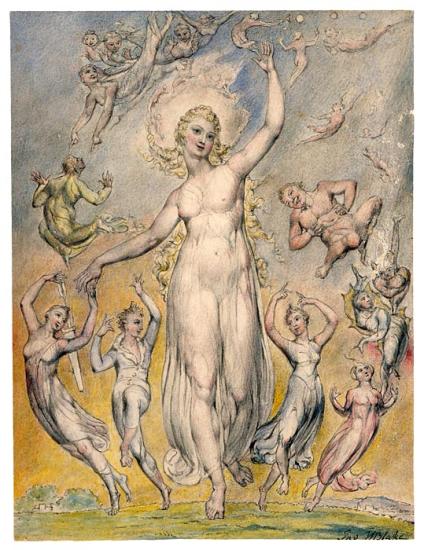
Mirth, illustration to Milton's L'Allegro
Signed in pen and black ink at lower right, Inv. W. Blake
Purchased with the assistance of the Fellows with the special support of Mrs, Landon K. Thorne and Mr. Paul Mellon
This drawing is the first of a series of twelve watercolors executed by Blake around 1816–20 as illustrations to L'Allegro and Il Penseroso, two poems by John Milton (1608–1674), the Romantics' favorite poet. Blake accompanied each watercolor with a transcription of Milton's text as well as an interpretation of the imagery.
Illustrating lines from L'Allegro, this drawing depicts the title figure of Mirth surrounded by the personifications of, among others, "Laughter holding both his sides" at center right; "Jest" and "Youthful Jollity," the boy and girl to the left and right of Mirth; and "Wreathed Smiles," the small spirits encircling Mirth's halo.
William Blake (1757–1827) occupies a unique place in the history of Western art. His creativity included both the visual and literary arts. In his lifetime he was best known as an engraver; now he is also recognized for his innovative poetry, printmaking, and painting. Blake's keen perception of the political and social climate found expression throughout his work. His strong sense of independence is evident in the complex mythology that he constructed in response to the age of revolution.
Blake was already recognized as an engraver at age twenty-five, when his first volume of poems appeared. At thirty-three, in The Marriage of Heaven and Hell, he audaciously claimed that his birth had marked the origin of a "new heaven" in which his own art would exemplify the creativity prefigured by Milton and Michelangelo. By that time, Blake, in one of his most productive periods, had already produced Songs of Innocence and was at work on a series of illuminated books. In 1818 he met John Linnell, a young painter and engraver, through whom a group of young artists became Blake's followers. Calling themselves the Ancients, they helped perpetuate Blake's influence for generations.
The Morgan's Blake collection—one of this country's most distinguished—began with purchases as early as 1899 by Pierpont Morgan. During the tenure of Charles Ryskamp, director from 1969 to 1986, major gifts almost doubled the size of its Blake holdings. In recent years Ryskamp's own gifts of engravings, letters, and related materials have significantly enriched its scholarly resources.
Milton's L'Allegro and Il Penseroso
The Morgan preserves Blake's twelve watercolor designs for Milton's early poems L'Allegro and Il Penseroso that contrast the cheerful man with the melancholic, thoughtful one. Like the illustrations for the Book of Job, Blake created them on commission for Thomas Butts about 1816–20. The two series were separated in 1903 and not reunited until 1949, when they were acquired as the first purchase by the Morgan's newly formed Association of Fellows.
Milton, along with Dante and the Bible, was one of Blake's great inspirations. Blake wrote a long and mystical poem, Milton, and executed several other series of illustrations for Milton's works.
Each of the watercolors in this series is accompanied by Blake's transcription of the relevant portion of the poem as well as his notes on his design.
Mirth. Allegro
1
Heart easing Mirth.
Haste thee Nymph & bring with thee
Jest & Youthful Jollity
Quips & Cranks & Wanton Wiles
Nods & Becks & wreathed smiles
Sport that wrinkled Care derides
And Laughter holding both his sides
Come & trip it as you go
On the light phantastic toe
And in thy right hand lead with thee
The Mountain Nymph Sweet Liberty
These Personifications are all brought together in the First Design. Surrounding the Principal Figure which is Mirth herself
This online exhibition is presented in conjunction with the exhibition William Blake's World: "A New Heaven Is Begun" on view September 11, 2009, through January 3, 2010.
This exhibition is made possible through the generosity of Fay and Geoffrey Elliott.
